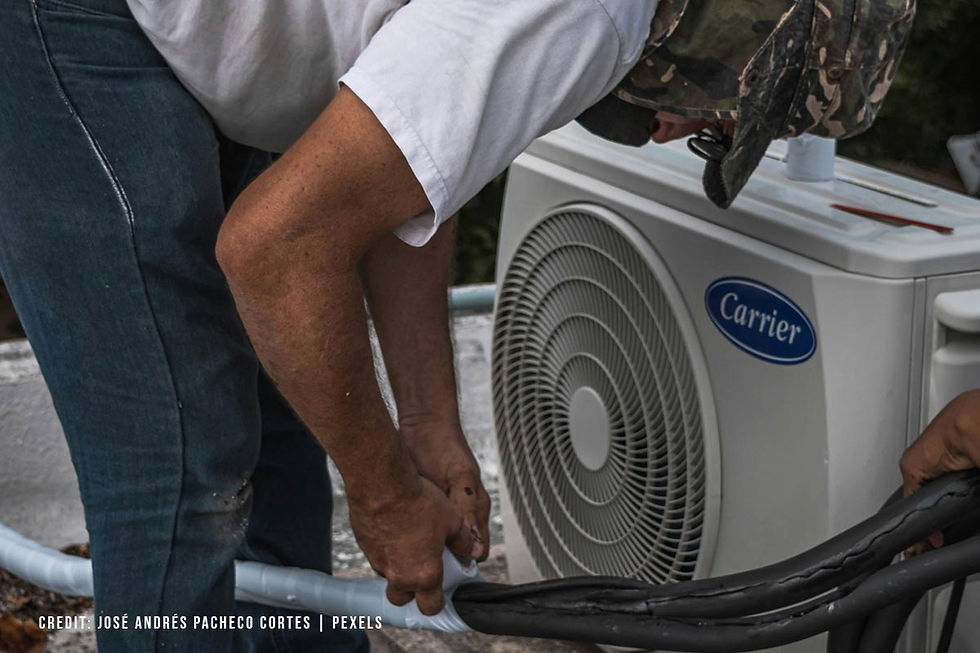Why Your AC Struggles in the Heat: Diagnosing and Fixing Common Summer Cooling Issues
- Berris McCleary
- Jul 13
- 6 min read

When summer finally arrives, many homeowners (Canadian and otherwise) find their air conditioning units working overtime over the season. And for all the AC’s efforts, it may only deliver lukewarm air or sometimes fail to cool their homes adequately. It can be a frustrating thing to have the air conditioner fail to function as intended, especially when the temperatures are soaring. While modern air conditioners are robust, they are not perfect, and therefore are not immune to issues that can hinder their performance, especially when faced with prolonged periods of high heat.
With temperatures rising and companies shifting to increased eco-friendliness, air conditioner prices are expected to rise as a response. Therefore, making the most of your existing air conditioner unit is a must to beat the heat and rising costs. Understanding why your AC might be struggling and how to diagnose and address common problems can go a long way toward saving you discomfort, excessive energy usage, and potentially costly repair bills.
1. Dirty Air Filters: The Silent Choker
One of the most frequent and easily remedied causes of a struggling AC is a dirty air filter. The air filter’s primary job is to protect your indoor coil and furnace from airborne particles such as dust and pet dander. However, if this filter clogs, the airflow over the evaporator coil becomes restricted, which can lead to complications. Firstly, the air conditioner has to work much harder to pull air through, leading to increased energy consumption and higher utility bills. Secondly, insufficient airflow can cause the evaporator coil to freeze over. When ice forms on the coil, it further impedes heat absorption, resulting in significantly diminished cooling capacity. As a consequence, your AC might run constantly but produce very little actual cooling.
Diagnosis:
Visually inspect your air filter. Hold it up to a light; if you can't see light through it, it's time for a change.
Feel the air coming from your vents. Is it weak, even if the unit is running?
Listen for a high-pitched whistling sound, which can indicate restricted airflow.
Fix:
Change your air filter every one to three months, or more frequently if you have pets or allergies. This simple maintenance step is crucial for efficient operation.
2. Refrigerant Leaks: The Slow Bleed
Refrigerant, often referred to as Freon, is the lifeblood of your air conditioning system. It circulates through the coils, absorbing heat from your home and releasing it outside. Unlike a car's engine oil, refrigerant is not consumed; it operates in a closed loop. Therefore, a low refrigerant level always indicates a leak. When the refrigerant charge is insufficient, the system cannot effectively transfer heat. This leads to a noticeable decline in cooling power, and the air coming from your vents may feel cool but not cold. Low refrigerant can also cause the evaporator coil to freeze, mimicking the symptoms of a dirty filter.
Diagnosis:
Lukewarm air blowing from the vents.
Hissing or bubbling sounds coming from the indoor or outdoor unit.
Visible ice on the refrigerant lines or the outdoor unit's coil.
Unexplained increase in energy bills, as the AC tries to compensate for the inefficiency.

Fix:
Refrigerant leaks are not a DIY fix. An HVAC technician is required to locate the leak and repair your air conditioner, and then properly recharge the system to the manufacturer's specifications. Adding more refrigerant without addressing the leak is a temporary solution and a waste of resources.
3. Dirty Outdoor Condenser Coils: The External Obstruction
Just as the indoor evaporator coil absorbs heat, the outdoor condenser coil is responsible for releasing that heat into the surrounding air. Over time, the condenser coil can become caked with dirt, leaves, grass clippings, and other debris. This accumulation acts as an insulating layer, preventing the coil from efficiently dissipating heat. When the condenser coil is dirty, the system struggles to shed the heat it has absorbed from your home, leading to reduced cooling capacity and increased stress on the compressor. The unit will run longer and consume more power to achieve less cooling.
Diagnosis:
Visually inspect the outdoor unit's coils. Are they covered in debris?
Feel the air coming from the top of the outdoor unit. Is it not as warm as it usually is when the unit is running efficiently?
The outdoor unit may be running constantly without effectively cooling the house.
Fix:
Before attempting this, ensure the power to the outdoor unit is completely off at the breaker.
Carefully use a garden hose to rinse off the condenser coils. Spray from the inside out to push debris outwards. Be gentle with the fins to avoid bending them.
For heavily soiled coils, a specialised coil cleaner may be necessary, but always follow the product instructions.
4. Thermostat Malfunctions: The Misguided Command
The thermostat is the brain of your air conditioning system, dictating when it turns on and off and what temperature to maintain. A faulty or miscalibrated thermostat can send incorrect signals to the AC, leading to various cooling issues. It might read the room temperature inaccurately, causing the system to cycle on and off too frequently (short cycling) or run continuously when it's not needed. Older mercury thermostats can lose their calibration, while digital thermostats can suffer from battery issues or internal malfunctions.
Diagnosis:
Inconsistent room temperatures, even when the thermostat is set to a specific temperature.
The AC turning on and off erratically.
The thermostat display is blank or flickering.
The system doesn't respond to thermostat adjustments.
Fix:
Check the batteries in your digital thermostat and replace them if necessary.
Ensure the thermostat is set to "cool" and the fan is on "auto."
Clean any dust or debris from inside the thermostat (after turning off the power to the HVAC system).
If the issue persists, a professional HVAC technician can diagnose and replace a faulty thermostat. Consider upgrading to a smart thermostat for better control and energy efficiency.

5. Frozen Evaporator Coil: The Icy Obstacle
A frozen evaporator coil is a common problem that can severely impact your AC's performance. As mentioned, dirty air filters and low refrigerant can cause this, but other factors include a blocked condensate drain line, which can lead to standing water and eventual freezing. When the coil freezes, it can't absorb heat from the air, meaning your AC will blow air that is barely cool, if at all, despite running continuously. The ice acts as an insulator, preventing the heat exchange process.
Diagnosis:
Warm or lukewarm air blowing from the vents.
Visible ice on the indoor coil or the refrigerant lines connected to it.
A puddle of water near the indoor unit (due to melting ice).
The outdoor unit is running but the indoor unit is not producing cold air.
Fix:
Turn off the AC system immediately at the thermostat and the breaker. Allow the coil to thaw completely, which can take several hours depending on the extent of the ice.
While it's thawing, address the underlying cause:
Change the air filter if it's dirty.
Inspect and clear the condensate drain line if it's clogged.
If you suspect a refrigerant leak, contact a professional.
Once thawed, restart the system. If the coil freezes again, a professional diagnosis is necessary to prevent further damage.
6. Undersized or Oversized Unit: The Fundamental Mismatch
While not a "fixable" common summer issue in the same vein as maintenance, a fundamental mismatch between your home's cooling load and your AC unit's capacity can lead to constant struggles. An undersized unit will run constantly, unable to keep up with the heat gain, resulting in high energy bills and insufficient cooling. Conversely, an oversized unit will "short cycle" – turning on and off too frequently. While this might seem efficient, it prevents the unit from effectively dehumidifying the air, leaving your home feeling clammy and uncomfortable, even if the temperature is somewhat cool. Short cycling also puts excessive wear and tear on the compressor, which can shorten the unit's lifespan.
Diagnosis:
An undersized unit will run almost non-stop on hot days, never quite reaching the desired temperature.
An oversized unit will cool the house quickly but leave it feeling humid, and the unit will turn on and off very frequently.
Fix:
This is a significant issue that requires a professional HVAC contractor to conduct a thorough load calculation (often called a Manual J calculation) to determine the appropriate size of AC for your home. If your unit is incorrectly sized, the only long-term solution is replacement with a correctly sized unit.
By understanding these common reasons why your AC might be struggling in the Canadian summer heat, you can often diagnose and address minor issues yourself, saving money and improving comfort. For more complex problems, such as refrigerant leaks or significant electrical issues, it's always best to call a qualified HVAC technician. Regular maintenance, including filter changes and coil cleaning, is paramount to prevent these issues and boost your HVAC efficiency through the hot summer months. Don't let the heat get the best of you; a little attention to your AC can make all the difference.
Your AC needs all the help it can get in summer, and JLN HVAC is here to provide it. We have a wealth of experience working on a wide range of HVAC systems, whether it’s maintaining an air conditioner unit or getting a furnace operational again. We’re only too happy to lend a hand and keep your home environment comfortable for you. Call us now at (647) 696-8915 and get the support your HVAC system needs to work.







Comments